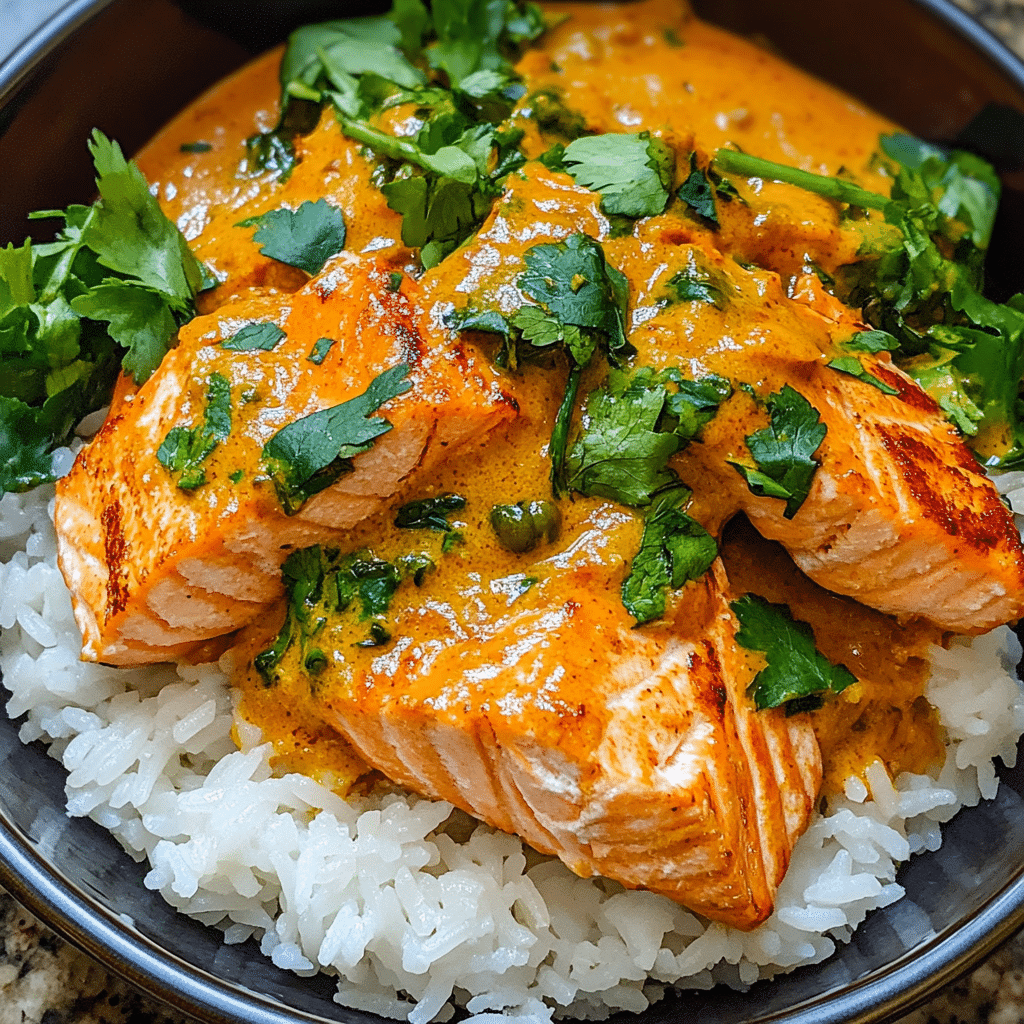If you’re craving a meal that effortlessly combines vibrant flavors with comforting textures, then the Curried Salmon Rice Bowl with Coconut Curry Sauce is about to become your new favorite dinner. This dish brings together tender, flaky salmon glazed in a creamy and aromatic coconut curry sauce, all served atop a bed of fluffy rice. Every bite offers a perfect balance of spice, sweetness, and richness, making it a quick yet indulgent choice for any day of the week.
Why You’ll Love This Recipe
- Speedy Preparation: Ready in under 30 minutes, making it ideal for busy weeknights.
- Balanced Flavors: The creamy coconut curry sauce perfectly complements the savory salmon.
- Nutritious Meal: Packed with omega-3 rich salmon, fresh veggies, and wholesome rice.
- Versatile Dish: Easily adapted to suit dietary preferences and ingredient availability.
- One-Bowl Convenience: Everything served in a single bowl for hassle-free cleanup.
Ingredients You’ll Need
The beauty of this Curried Salmon Rice Bowl with Coconut Curry Sauce lies in its simple yet essential ingredients, each playing a vital role in building layers of flavor, texture, and color. From creamy coconut milk to fresh herbs, these components come together effortlessly.
- Fresh Salmon Fillets: Choose wild-caught if possible for the best flavor and texture.
- Basmati or Jasmine Rice: Fluffy, fragrant rice makes the perfect base for the rich sauce and salmon.
- Coconut Milk: Adds creaminess and a subtle sweetness to the curry sauce.
- Curry Powder: The aromatic backbone that brings warmth and spice.
- Garlic and Ginger: Fresh ingredients that deepen the sauce’s flavor profile.
- Vegetables like Bell Peppers and Spinach: For freshness, color, and added nutrients.
- Lime or Lemon Juice: A squeeze of citrus brightens up the entire bowl.
- Fresh Cilantro: Garnishes and adds a refreshing herbal note.
- Vegetable or Olive Oil: Essential for sautéing and sealing in flavors.
- Salt and Black Pepper: To season perfectly.
Variations for Curried Salmon Rice Bowl with Coconut Curry Sauce
This recipe is wonderfully flexible, allowing you to personalize it depending on what you have at home, your dietary needs, or simply your taste buds’ desires. Here are some exciting variations to inspire your cooking journey.
- Swap the Protein: Use shrimp, tofu, or chicken instead of salmon for different flavors and textures.
- Adjust the Heat: Add a chopped chili or a pinch of cayenne pepper for extra spice.
- Change Up the Grains: Substitute rice with quinoa, couscous, or cauliflower rice for a different base.
- Vegetable Mix-In: Try zucchini, snap peas, or carrots for additional crunch and variety.
- Dairy-Free Option: The recipe is naturally dairy-free, so it’s perfect for those avoiding dairy.
How to Make Curried Salmon Rice Bowl with Coconut Curry Sauce
Step 1: Prepare the Rice
Start by rinsing your choice of rice until the water runs clear, then cook it according to package instructions. Fluffy, perfectly steamed rice forms a crucial foundation for the dish, absorbing the rich coconut curry sauce beautifully.
Step 2: Sauté Aromatics
In a large skillet, heat oil over medium heat and add finely chopped garlic and ginger. Cook until fragrant and golden, about 1-2 minutes, which creates a wonderfully aromatic base for your curry sauce.
Step 3: Make the Coconut Curry Sauce
Sprinkle in curry powder and stir to toast it gently with the aromatics. Pour in the coconut milk slowly, mixing well. Let the sauce simmer softly to thicken and deepen its flavor, about 5-7 minutes.
Step 4: Cook the Vegetables
Add your choice of vegetables such as sliced bell peppers and fresh spinach to the skillet. Simmer for an additional 3-4 minutes until they are tender yet vibrant, ensuring a fresh pop of color and nutrients in every bite.
Step 5: Pan-Seared Salmon
While the sauce simmers, heat a separate pan over medium-high heat. Season salmon fillets with salt and pepper, then sear them skin side down first for 4-5 minutes until crispy. Flip and cook for another 2-3 minutes until the salmon is flaky and cooked through.
Step 6: Assemble the Bowl
Place a generous scoop of rice into each bowl, ladle the coconut curry and veggies over the top, then gently place the salmon fillet on the side or right on top. Finish with a squeeze of lime and a sprinkle of fresh cilantro for brightness.
Pro Tips for Making Curried Salmon Rice Bowl with Coconut Curry Sauce
- Use Fresh Ingredients: Fresh garlic, ginger, and herbs dramatically elevate the curry’s flavor.
- Don’t Overcook the Salmon: Aim for slightly underdone in the center as it will continue to cook while resting.
- Toast Your Spices: Lightly toasting curry powder before adding liquids intensifies the aroma.
- Customize Spice Levels: Start with mild curry powder and add chili gradually to suit your heat preference.
- Rest Your Protein: Let the salmon rest a few minutes after cooking to retain juiciness.
How to Serve Curried Salmon Rice Bowl with Coconut Curry Sauce
Garnishes
Top your bowl with fresh cilantro leaves, thinly sliced green onions, and a wedge of lime or lemon for a zesty burst that cuts through the creamy sauce beautifully.
Side Dishes
Pair with light sides like cucumber salad, pickled vegetables, or steamed greens to balance the rich, spicy flavors throughout the meal.
Creative Ways to Present
Serve in colorful bowls layered with contrasting veggies for a photogenic meal, or use edible flowers and toasted coconut flakes to add a sophisticated touch.
Make Ahead and Storage
Storing Leftovers
Store leftovers in an airtight container in the refrigerator for up to 3 days, keeping the salmon separate from the rice to preserve texture.
Freezing
This dish can be frozen, but it’s best to freeze only the coconut curry sauce and cooked rice. Freeze in portions and add freshly cooked salmon when ready to serve.
Reheating
Reheat gently in a saucepan or microwave with a splash of water or coconut milk to restore creaminess, avoiding drying out the salmon by warming it separately.
FAQs
Can I use frozen salmon for this recipe?
Yes, frozen salmon works well; just thaw it completely and pat dry before cooking to ensure a nice sear.
Is this recipe spicy?
It’s mildly spiced but can be adjusted by increasing or reducing the amount of curry powder and adding fresh chili or cayenne pepper.
Can I make this dish vegetarian or vegan?
Definitely! Replace the salmon with tofu or chickpeas for a plant-based twist, keeping the coconut curry sauce as is.
What type of rice is best for the bowl?
Basmati or jasmine rice works best due to their fragrant aroma and fluffy texture, though any long-grain rice will suffice.
How do I store leftovers without losing flavor?
Keep components separate when storing; mix them just before reheating to keep textures fresh and flavors vibrant.
Final Thoughts
There’s something truly special about the Curried Salmon Rice Bowl with Coconut Curry Sauce—a dish that’s both comforting and adventurous on the palate. Whether you’re cooking for a quick weeknight dinner or impressing friends with a vibrant homemade meal, this recipe delivers in every way. Give it a try and enjoy all the warmth and flavor it brings to your table!
Related Posts
- Why Hot Honey Chicken Bowls Are a Must-Try
- Why Creamy Marry Me Shrimp Pasta Wins Hearts
- Best Crispy Parmesan Ranch Chicken Tenders Recipe

Curried Salmon Rice Bowl with Coconut Curry Sauce
- Total Time: 30 minutes
- Yield: 4 servings 1x
- Diet: Gluten Free
Description
The Curried Salmon Rice Bowl with Coconut Curry Sauce is a delightful fusion of tender, flaky salmon served on a bed of fluffy rice and topped with a creamy, aromatic coconut curry sauce. This quick and nutritious meal balances warm spices, subtle sweetness, and fresh herbs, making it perfect for busy weeknights or an indulgent anytime dinner.
Ingredients
Proteins
- 4 fresh salmon fillets (wild-caught recommended)
Grains
- 1 1/2 cups basmati or jasmine rice
Sauce Ingredients
- 1 can (13.5 oz) coconut milk
- 2 tbsp curry powder
- 2 cloves garlic, finely chopped
- 1 tbsp fresh ginger, finely chopped
- 1 tbsp vegetable or olive oil
- Salt, to taste
- Black pepper, to taste
Vegetables
- 1 cup sliced bell peppers (any color)
- 2 cups fresh spinach leaves
Garnishes & Extras
- Juice of 1 lime or lemon
- Fresh cilantro leaves, for garnish
Instructions
- Prepare the Rice: Rinse your rice under cold water until it runs clear, then cook according to package instructions to yield fluffy, perfectly steamed rice.
- Sauté Aromatics: Heat oil in a large skillet over medium heat. Add finely chopped garlic and ginger, cooking for 1-2 minutes until fragrant and golden, creating a flavorful base.
- Make the Coconut Curry Sauce: Sprinkle curry powder into the skillet and stir to lightly toast for 30 seconds. Slowly pour in the coconut milk while mixing, then allow the sauce to simmer gently for 5-7 minutes to thicken and deepen in flavor.
- Cook the Vegetables: Add sliced bell peppers and fresh spinach to the sauce. Simmer for another 3-4 minutes until vegetables are tender but still vibrant.
- Pan-Seared Salmon: Meanwhile, heat a separate pan over medium-high heat. Season salmon fillets with salt and black pepper. Place skin side down, searing for 4-5 minutes until crispy, then flip and cook for 2-3 minutes until salmon is flaky and cooked through.
- Assemble the Bowl: Spoon a generous serving of rice into each bowl, ladle the coconut curry with vegetables over it, then gently place the salmon on top or to the side. Finish with a squeeze of lime juice and garnish with fresh cilantro leaves.
Notes
- Use Fresh Ingredients: Fresh garlic, ginger, and herbs dramatically elevate the curry’s flavor.
- Don’t Overcook the Salmon: Slightly undercook the center as it will continue to cook while resting.
- Toast Your Spices: Lightly toasting curry powder before adding liquids intensifies aroma.
- Customize Spice Levels: Add fresh chili or cayenne gradually to suit heat preference.
- Rest Your Protein: Let salmon rest a few minutes after cooking to retain juiciness.
- Prep Time: 10 minutes
- Cook Time: 20 minutes
- Category: Main Course
- Method: Sautéing
- Cuisine: Fusion
Nutrition
- Serving Size: 1 bowl
- Calories: 550 kcal
- Sugar: 4 g
- Sodium: 320 mg
- Fat: 30 g
- Saturated Fat: 18 g
- Unsaturated Fat: 10 g
- Trans Fat: 0 g
- Carbohydrates: 35 g
- Fiber: 4 g
- Protein: 35 g
- Cholesterol: 70 mg


